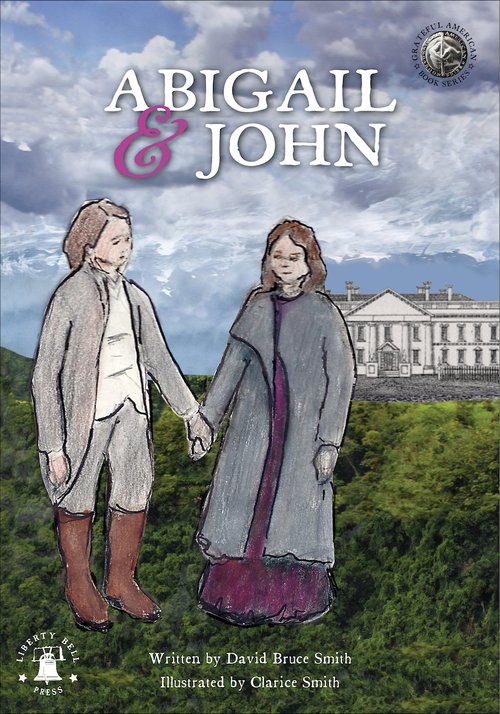This is the first part of a continuing series of blog posts with author David Bruce Smith about Abigail and John Adams. Historic Deerfield’s resident historians will pose questions to Smith, who is the author of Abigail & John , a nonfiction children’s book that offers readers the opportunity to view prominent scenes in American history through the remarkable lives of one of the country’s most beloved couples—the Adams’s. Exploring the historical significance of a partnership that spanned over five decades, the book details the love they shared for each other and the country. We hope this blog can be a helpful historical resource for learners of all ages.
1. While John Adams was certainly a Founding Father, was he a good parent, and what is known about his parents?
John Adams was the son of John Adams, Sr., a genial multitasker, who was a farmer, cordwainer, lieutenant in the militia, and an active councilman. He had a loving relationship with his son, but in that orb, his wife, Susanna Boylston Adams, fell short. She was a socialite of sorts, with unpredictable emotions that overflowed, disrupted the house, and frightened her four children. Today, many people would probably agree she was a manic depressive—the illness she seemed to have passed on to her son, the prickly president-to-be.
Abigail was the “antidote” in John’s life; she managed his moods, and enabled his political progression; without her, it is unlikely he would have made it to the White House.
As a parent, John juggled the colliding responsibilities of an ascending politician, long absences from the family, and a particularly passionate partnership with his wife. Abigail permeated nearly all parts of his personality, sometimes to the exclusion of others. She was John’s best friend and lover; sole confidante; and most valued advisor.
As a couple, they lived many stories: Abigail raising the children alone on the farm without any slaves—an unpopular position for the time; surviving the death of their daughter, Susanna; Abigail choosing to inoculate herself, and the children with a smallpox vaccine that could have killed them all.
Although John missed out on a decade’s worth of milestones in their lives, Abigail removed his remoteness with loving, informative letters. The two exchanged more than 1,000—from their years of courtship, to her 1818 death.
Abigail and John were undeniably in love—perhaps too much; the children—and less so, John Quincy—had compromised lives.
Early on, Abigail and John earmarked John Quincy for greatness; from childhood to adulthood, he was prodded, pushed, and parentally prepared for politics—and the presidency. It was a life he might not have wanted, but he was going to have it.
Abigail “Nabby” Adams: She married her father’s secretary during his years as the ambassador to Great Britain. Colonel William Stephens Smith was ten years her senior; a kind man, who was never satisfied in his various jobs, he spent more than he made, and bankrupted his family in an early 1800s real estate speculation. She died from breast cancer in 1813 at the age of 48.

Charles Adams, a graduate of Harvard, Adams moved to New York to work in the office of Alexander Hamilton, but after he was appointed Secretary of Treasury, Adams switched to another legal office. He passed the bar in 1792 and married the sister of Nabby’s husband. Eventually, Adams became an alcoholic, had numerous affairs, and died at age 30; disowned by his father, diseased by cirrhosis of the liver, and destitute.
Thomas Adams: John Quincy did not believe his brother had the capabilities to practice law competently, so he settled in Quincy, Massachusetts, and became the town’s representative to the state’s legislature. Later, he was appointed chief justice of Circuit Court of Common Pleas in the Southern Circuit of Massachusetts.
An alcoholic like Charles, Thomas died in 1832 at the age of sixty.
2. Who was “X Y Z,” and why wouldn’t Adams tell his people who they were?
When France went to war with Great Britain in 1793, George Washington declared a position of neutrality. The following year, the United States and Britain negotiated the Jay Treaty; it was intended to settle some of the ripples between the two countries, but France, feeling betrayed and excluded, retaliated by commandeering American ships.
Washington dispatched Charles Cotesworth Pinckney, [later Madison’s foe in the 1808 presidential election], to stabilize the situation, but Paris refused to receive him.
After Adams rose to the presidency in 1796, he sent a three-man delegation to France—Pinckney, John Marshall [later appointed Chief Justice by Adams], and Elbridge Gerry [Madison’s second term vice president, who died in office]—to restore peace, but Foreign Minister Charles de Talleyrand, put them off, and ordered his representatives to inform the Americans: a meeting was possible only if he was paid a hefty bribe, and France received a substantial loan.
Gerry allegedly responded, “No! No! Not a sixpence!”
Once these warped words reached America, the country’s rage ramped up, and Congress demanded the release of the diplomats’ reports; when Adams handed over the documents, the names of the French agents had been substituted with the letters, “X Y Z” to diffuse the delicate dilemma, but the strategy backfired.
Now, at the very edge of a material conflict, Adams formed the Department of Navy, and Congress authorized the construction of warships; by July of 1798, American attacks on French vessels were being sanctioned-if necessary, but the seas remained still.
Meanwhile, the president’s popularity soared; he had kept the country out of battle, and the undeclared “Quasi-War”, was ended with the 1801 ratification of the Treaty of Mortefontaine.
Illustrations by Clarice Smith.